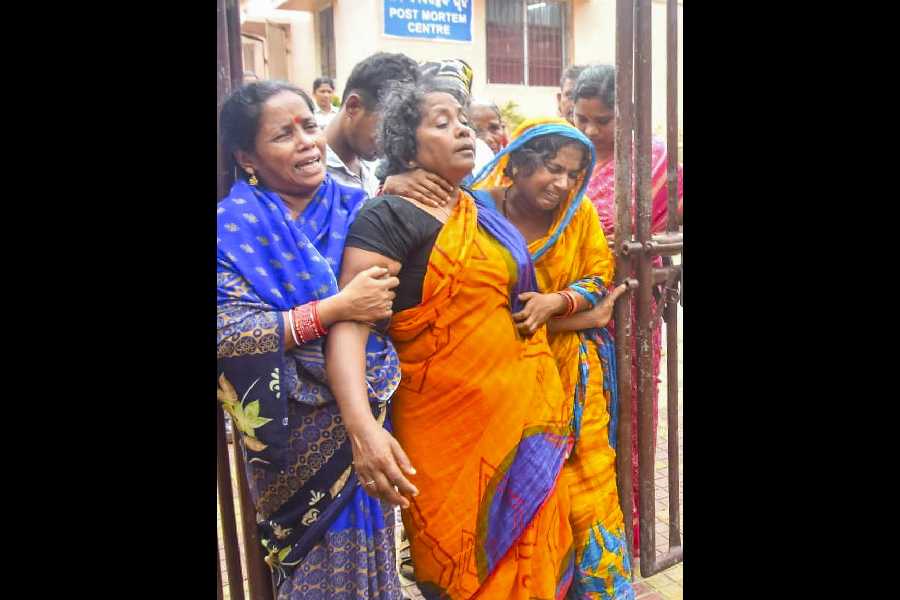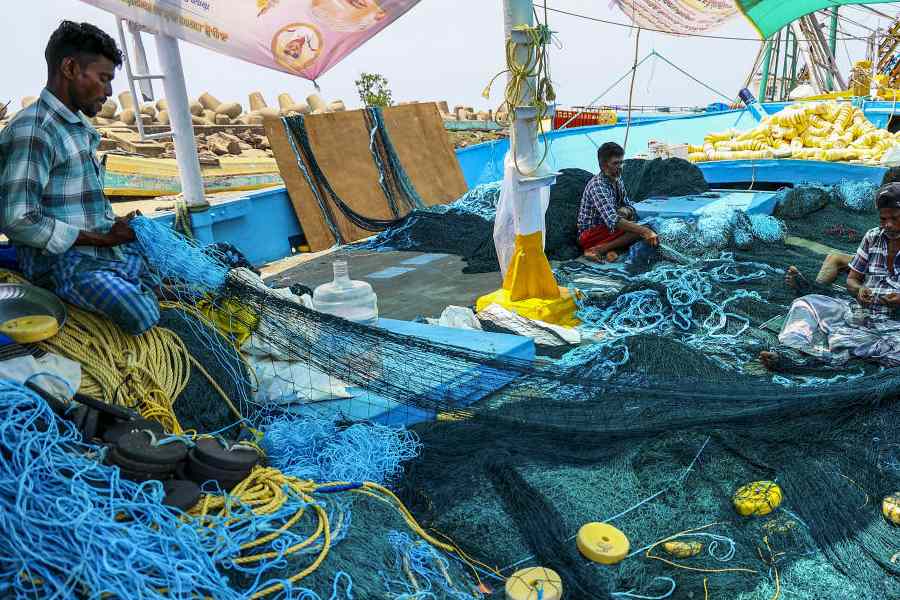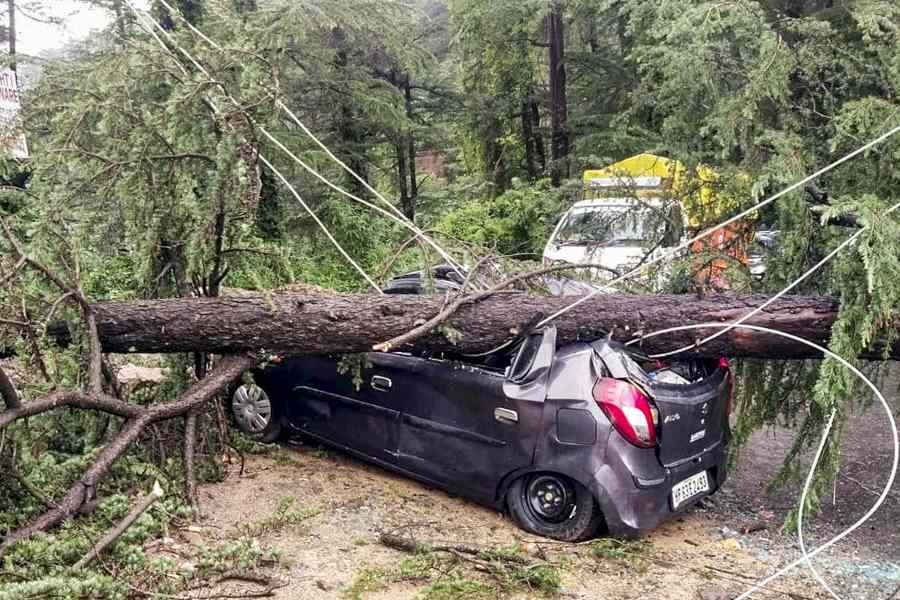Kathmandu, April 13: ?Dr Baburam Bhattarai cleared the design of this building,? the taxi driver pointed to the showpiece Birendra International Conference Centre. Not true ? it was designed and gifted by China.
?Dr Baburam Bhattarai designed the Rashtriya Banijya Bank, opposite Singha Durbar, in such a way that every room gets natural sunlight,? he went on. True, some say. Bhattarai did study architecture at Chandigarh and Delhi.
?He was such a good architect that the Americans offered him 1 lakh dollars to work for them but he refused,? the taxi driver went on. Can?t be verified.
So what does Baburam Bhattarai do these days? ?Woh Maobadi ka raja hai (he is the King of the Maoists),? he explained.
However, there are strong rumours in Kathmandu that the Raja of Maobadi may have been placed under arrest by his own comrade and leader Prachanda, also known as Pushpakamal Dahal.
The first indication of trouble in the Maoist leadership came in March when the Royal Nepal Army claimed that Bhattarai and his wife Hisila Yami had been thrown out of the party.
However, through a public statement the Maoists clarified that both were still in the party.
Then came a letter by Bhattarai and his wife, dated March 24, which was smuggled out and published in a magazine that indicated that they were under arrest. It said: ?We are glad to be under the glorious protection of the people?s red army? and that this was preferable to being in the king?s jail.
Last Thursday, the foreign office showed some photographic evidence of posters in the interiors of the country against Prachanda, ostensibly put up by Bhattarai?s supporters, to a group of diplomats. In short, there is enough indication of major ideological and personal differences between Bhattarai and Prachanda.
Sudheer Sharma, editor of Nepal magazine, has analysed the context within which differences have grown between Bhattarai and Prachanda. Sharma claims that Bhattarai, his wife Hisila Yami and another supporter and politburo member, Dinanath Sharma, have been divested of party posts. All this happened in February this year just when the king was taking over power.
The decision of the politburo against Bhattarai and Hisila Yami was not unanimous, according to Sharma, with seven out of 14 full members present (three are imprisoned in India) writing a note of dissent. Ten alternate members do not have voting rights.
Shyam Shreshtha, who was once in the Maoist politburo and now edits a Left-wing magazine Mulyankan, says: ?I do not personally believe that Baburam Bhattarai is under arrest. But I also do not believe that nothing has happened. My information is that he has been suspended for six months from the central committee and politburo on the issue of inner-party democracy. Of this two months are already up.?
According to Sudheer Sharma, major differences surfaced among the Maoists during the last plenum of the central committee held in August 2004.
?There were two vital decisions which led to differences between Prachanda and Bhattarai ? one, in deciding to go for a strategic offensive, the Maoists identified India as the primary enemy which might interfere militarily or sabotage their talks with the king; second, the decision on inner-party democracy taken a year ago in pursuing the line known as ?the development of new democracy in the 21st century (Ekkeeswin Shatabdi Ka Janwad)? was suddenly withdrawn. It had argued against democratic centralism and for greater inner-party democracy. Both these decisions upset Bhattarai.?
Bhattarai?s view, Sharma claims, was that the main enemy was the monarchy. He apparently argued that to establish a democratic republic, as opposed to a communist republic, even India?s help was needed.
Sharma says: ?Bhattarai warned against looking hopefully towards the king for a compromise and argued against peace talks with him.?
Bhattarai also wrote in Kantipur daily against lack of inner party democracy and the ?raja-rajouta pravratti (feudal tendency)? of the Maoist leadership.
His explanation was sought and he replied with a 13-point reply that challenged the leadership further. He questioned the elevation of the revolutionary path called ?Prachandapath? to ?Thoughts of Prachanda?, the centralisation of party, army and state posts in one person and adding Prachanda?s photograph to the pantheon of Marx, Engles, Lenin, Stalin and Mao.
According to a source close to the Maoists, ?In the August plenum, Prachanda wanted to be declared head of the underground government as well as the party and the people?s army. Bhattarai was the head of the underground government till then. He objected and a debate ensued. The differences essentially are about democratic centralism and not about India being designated the main enemy.?
The source explained, ?The decision on ?Ekkeeswin Shatabdi ka Janwad? was taken at a conference and it cannot be overruled by the central committee. It is Prachanda who has gone against the party line and not Bhattarai.?
Nobody, however, expects the situation to escalate. ?There will be no split. Prachanda does not want to expel Bhattarai. He only wants to control him. Bhattarai is also not in favour of launching a new party,? says Sudheer Sharma.
Sharma feels that once the news of Prachanda?s treatment of Bhattarai percolates to the entire cadre, the party would not be able to allow confusion to prevail. A party body larger than the politburo will have to settle the issue, he feels.
Shreshtha feels that unless the debate snowballs ? and there is no indication of that as yet ? only then the Maoist leadership might call a conference to sort it out.
?But it is a setback. There will be frustration among the cadre. When people are unhappy, their effectiveness is bound to be impacted. But there will be no revolt in the Maoist rank,? said a source who studies the Maoists closely.











